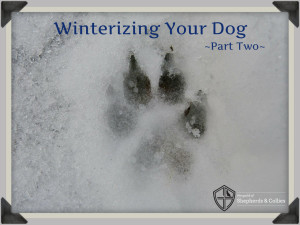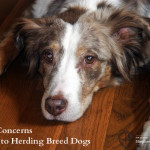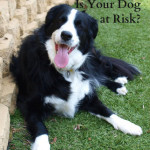Winterizing Your Dog, Part 2

When it comes to the health of your dog, you are always willing to go above and beyond to keep your loyal friend happy and safe. This includes protecting him from unseen dangers, such as accidental poisoning. It may seem strange, but your dog is more likely to come in contact with toxic substances in the winter than the summer.
Herding breeds can be rambunctious and are often incredibly inquisitive, requiring a little more awareness on your part. Protecting your dog from accidental poisoning isn’t hard - it just takes diligence and savvy to help avoid exposure.
Identifying Threats and Preventing Poisonings
ANTIFREEZE
Antifreeze is easily the most toxic substance your dog might come into contact with during the winter or summer. The most common place for pets to find and consume it is a driveway or sidewalk where it has leaked from a car’s radiator. There is also the possibility that when this occurs, it can be carried into the public runoff system (such as gutters), making it accessible, even several hundred yards from the initial spill point. Watch for fluid running out from under cars and take steps to make sure your dog doesn’t lick up the offending liquid.
If you maintain your cars at home, make sure all fluid containers are tightly sealed and stored up high where your pet can’t reach them. This goes for windshield washer fluid and transmission fluid, as well. Both of these can contain ethylene glycol in concentrations strong enough to cause harm. Also be aware of any open pans that may be being used to collect leaks from radiators or other auto systems. Neighbors may unintentionally leave these out, making them a prime spot for your canine friend and other animals in the neighborhood to take a lethal sip.
If you happen to spill a bit when refilling your radiator, topping off your wiper fluid or your ATF (automatic transmission fluid), throw cat litter, sawdust or another absorbent material onto the spill. Immediately clean up the mess, disposing of it according to your city’s ordinances.
Some common symptoms of antifreeze poisoning include:
- “Drunken” behavior, such as stumbling and staggering.
- Nausea and vomiting
- Weakness
- Heart palpitations
- Diarrhea
- Excessive urination
Any of these symptoms could also be signs of other problems aside from antifreeze poisoning, which is why it is of the utmost importance to get your dog in right away.
If, for any reason you have seen or suspect your dog has somehow consumed antifreeze, get him to a veterinarian immediately. They will be able to run tests and get him on supportive care that could mean the difference between life and death.
RODENT POISONS
As the cold starts to creep in, so do the mice and rats, looking for warmer places to nest. To counter this invasion, many people use commercial rodent baits full of poisons. There are four main types of toxic substances used in rodenticides. Unfortunately, they all require different treatment, and for some there is no antidote. If there is ANY thought in your mind that your dog may have eaten rat bait, it is incredibly important that you isolate what brand and formula it could have been. This information is key in providing proper treatments.
The four main poisons include:
Cholecalciferol – this activated form of Vitamin D3 is used in mega doses in rat bait to cause the calcium and phosphorus levels in the blood to rise to fatal levels, causing acute kidney failure. Some of the symptoms of ingestion include:
- Polyuria and polydyspia (increased urination and thirst)
- Lack of appetite
- Weakness
- Lethargy
Long-acting & Short-acting Anticoagulants – these can include substances like warfarin or coumadin, blocking the production of Vitamin K, an essential vitamin that helps with normal blood clotting. This causes uncontrollable bleeding, both internally and externally. Luckily, if caught early enough, this is one of the easiest poisonings to treat and reverse. Some of the symptoms of ingestion include:
- Lethargy
- Bloody stools or bloody vomit
- Weakness and lack of stability
- Excessive bleeding of the gums
- Swollen belly
Zinc Phosphide – a particularly insidious poison, zinc phosphide turns to phosphine gas when exposed to stomach contents. Because of this, it is incredibly important that you contact your veterinarian prior to arrival, so that they can properly prepare for handling this unique emergency. Phosphine gas causes significant damage to internal organs by crossing cell barriers, preventing them from producing energy, then causing consequential cell death. It targets the heart, lungs and liver. Symptoms of zinc phosphide poisoning can include:
- Nausea and vomiting (the vomit may be bloody)
- Loss of appetite, abdominal pain
- Diarrhea
- Incoordination
- Paralysis
Bromethalin – Bromethalin is another popular poison for use in rodenticides. It has gained popularity in the last few years, with dire consequences. There is no test available to detect its presence in the body, nor is there an antidote. It works as a neurotoxin, targeting the cells of the brain and liver. It basically causes huge sodium accumulations to occur in the cells of the brain, resulting in excessive swelling of brain tissue and subsequent central nervous system failure. Some of the symptoms of bromethalin poisoning can include:
- Weakness
- Muscle tremors
- Paddling motions of the limbs
- Unsteadiness
- Depression
- Vomiting
- Hyperexcitability
- High fever
- Stiffness in the front legs
- Seizures
These are all grim to consider for the animal targeted by the bait, but what’s even worse is when it affects not only the animal that has initially ingested it, but other creatures that might then consume that animal. It’s not uncommon for dogs to get a hold of these rodents and then become sick themselves. Secondly, if the bait is readily available, most dogs will eat it without hesitation. Most are carried in a base that smells and tastes good, in an effort to encourage rodents to consume it.
If you have a large rodent invasion, consider calling in an exterminator that uses non-poisonous methods to eliminate mice or rats in your environment. Don’t use poison baits; if a particularly robust mouse gets a hold of it, it can easily be carried into the path of your unsuspecting canine. As we’ve all seen demonstrated by New York’s “Pizza Rat,” these creatures are incredibly adept at moving their food from one point to another. While this is a less likely scenario than antifreeze poisoning, it’s still not uncommon for veterinary offices to see a handful of these cases in the late fall and early winter months.
If you have seen your dog catch and eat a rodent, or suspect rodenticide poisoning, contact a veterinarian immediately.
ICE MELT
Another chemical culprit we often don’t think about is road salt or ice melt. These ingenious little granules can be the difference between getting to work or not most mornings in colder regions. While not nearly as toxic as the poisons mentioned above, ice melts can still cause significant discomfort and illness if consumed in large enough quantities.
Active dogs, such as our beloved herding breeds, need A LOT of exercise, regardless of weather conditions. This usually means bundling up and going for daily walks to burn off some of their excess energy. Regardless of whether you’re just taking a stroll around the block, or going for a power walk, it’s essential to take care of your pup’s feet before and after.
The active ingredients in most ice melts are a blend of different salts that work to melt ice and snow and prevent refreezing. The formulas containing ureas are considered “pet safe,” but can still sicken your dog if consumed in any quantity. Most consumption occurs after playing outside and then licking the resulting accumulation of ice melt from their paws.
Vomiting and GI distress are the most common side effects, with more severe problems like electrolyte imbalances if your dog has consumed a large quantity. If you suspect that your dog has eaten any amount of ice melt, call your veterinarian for further advice.
- If your dog will tolerate them, waterproof boots are a great way to keep your dog’s feet warm, dry, and ice melt free.
- Don’t allow your dog to drink out of puddles where ice melt may have been used.
- Try to avoid areas where there is an overabundance of this substance put down. Don’t allow your dog to roll or nose around in snow that has had ice melt applied to it.
- Don’t allow your dog to eat snow in or near areas that may have been treated with ice melt.
- When you arrive back from you walk, rinse your pup’s feet with warm, clear water and dry thoroughly. This will help wash away any accumulated salts.
Although all of the above information is a bit overwhelming, with a little extra vigilance, winter poisonings can be prevented. If you have any questions or concerns, or simply want to learn more about preventing accidental poisonings in your pets, the ASPCA Poison Control site offers a lot of great information, as does the Pet Poison Helpline.
Article By:
Jennie Eilerts






